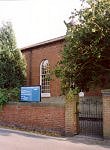The United Reformed Church
Pinfold Lane, Repton, Derby DE65 6GH
The Congregational Church in Repton started life in 1780 when members of the Victoria Street Congregational Church in Derby formed missions in Repton and Barrow upon Trent. For many years, services were held in Acton Cottage in the High Street, the home of church members, and in 1801, in the words of the historian, 'a neat little brick chapel was built at the top of the garden belonging to the house'. Graves can still be found in the back garden.
The Toleration Act of 1689 was supposed to guarantee freedom of worship as long as new churches were built not less than seven miles from a parish church. This meant that village churches had to worship in houses, as in Repton, and faced closure if they were reported to the authorities. However, following the repeal of the Test and Corporation Acts in 1828, free churches realised that sentiment was moving in their direction and started planning their own buildings. For many years, the chapel had been too small to house the congregation, and permission for the chapel in Repton was granted in 1835. Following the induction of Rev Horatio Ault on 14th June 1836, a discussion took place with ministers of the district about building a new church. As a result £160 was donated immediately, and two months later building began. After a further seven months the church was completed, at a cost of £434, and opened for public worship on 15th March 1837, when two days of celebrations included five sermons!
After many years of discussions throughout the country, the Congregational Church and English Presbyterian Church joined together to form the United Reformed Church, commemorated at a service in Westminster Abbey on 5th October 1972. The United Reformed Church later welcomed the Churches of Christ into the union.
The schoolroom was added in 1845 at a cost of £200 and the village day school opened there, providing education for local children on weekday mornings as well as a Sunday School. It was run by the Congregational church with 100 children enrolled, although the average attendance was 75. Children paid one penny a week to attend and the teacher was paid £25 per annum. By the time the school closed - on 29 February 1884 - the teacher's salary had risen to £50. By now referred to as 'The Old Schoolroom', it was renovated in 2015 and rededicated on 13th March 2016.
